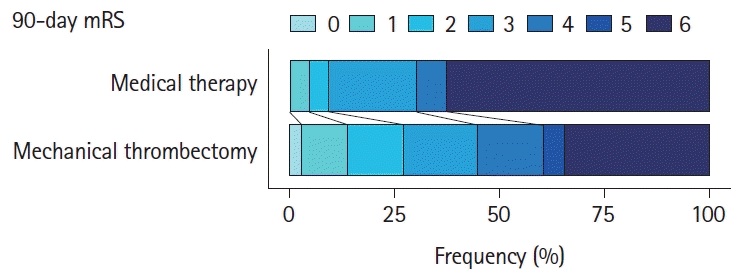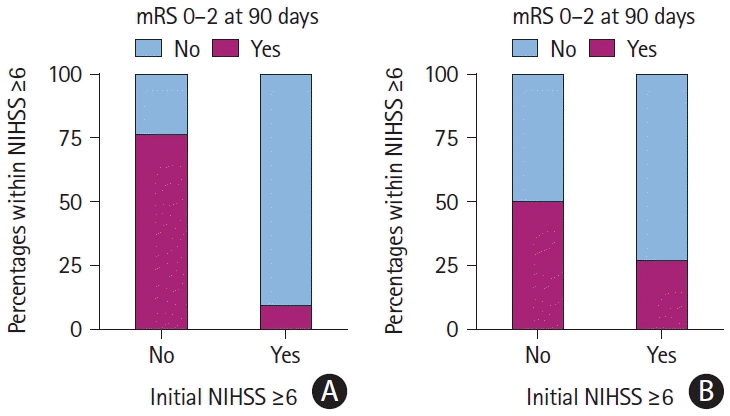Introduction
Methods
Clinical variables
Outcomes
Statistical analysis
Results
Table 1.
Data are presented as mean±standard deviation (range) or n (%) unless otherwise indicated.
MT, mechanical thrombectomy; SMT, standard medical therapy; IQR, interquartile range; LSW, last seen well; BMI, body mass index; ED, emergency department; BP, blood pressure; mRS, modified Rankin Scale; NIHSS, National Institutes of Health Stroke Scale; NCCT, non-contrast computed tomography; MRI, magnetic resonance imaging; ASPECTS, Alberta Stroke Program Early Computed Tomography Score; CTA, computed tomography angiography; MRA, magnetic resonance angiography; ACA, anterior cerebral artery; PCA, posterior cerebral artery; VA, vertebral artery; BA, basilar artery; ICA, internal carotid artery; mTICI, modified thrombolysis in cerebral infarction; ESUS, embolic stroke of undetermined source.
Outcomes measures
Table 2.
| SMT (n=120, 36%) | MT (n=214, 64%) | P | |
|---|---|---|---|
| Any ICH | 14 (12) | 55 (26) | 0.002 |
| sICH | 3 (2.5) | 12 (5.6) | 0.19 |
| Cerebral edema in same arterial territory with midline shift | 25 (20.8) | 26 (12.1) | 0.03 |
| Hemicraniectomy | 7 (5.8) | 8 (3.7) | 0.38 |
| Predischarge NIHSS | 14±15 (0–42) | 15±14 (0–42) | 0.07 |
| 90-day mRS* | 4±2 (0–6) | 4±2 (0–6) | 0.20 |
| Median (IQR) | 3 (1–6) | 4 (2–6) | 0.20 |
| mRS 0-2 at 90 days* | 34 (40) | 49 (28) | 0.04 |
| Mortality at 90 days* | 32 (38) | 61 (34) | 0.55 |
Data are presented as mean±standard deviation (range) or n (%) unless otherwise indicated.
MT, mechanical thrombectomy; SMT, standard medical therapy; ICH, intracranial hemorrhage; sICH, symptomatic intracranial hemorrhage; NIHSS, National Institutes of Health Stroke Scale; mRS, modified Rankin Scale; IQR, interquartle range.
Subgroup analysis
Figure 1.

Figure 2.

Table 3.
| SMT (n=59, 22%) | MT (n=204, 78%) | P | |
|---|---|---|---|
| Any ICH | 13 (22.0) | 51 (25.0) | 0.64 |
| sICH | 3 (5.1) | 9 (4.4) | 0.73 |
| Classification of ICH | 0.43 | ||
| None | 49 (83.1) | 161 (78.9) | |
| HI1 | 2 (3.4) | 18 (8.8) | |
| HI2 | 5 (8.5) | 11 (5.4) | |
| PH1 | 0 (0) | 4 (2.0) | |
| PH2 | 3 (5.1) | 6 (2.9) | |
| SAH | 0 (0) | 4 (2.0) | |
| Cerebral edema in same arterial territory with midline shift | 20 (33.9) | 26 (12.7) | <0.001 |
| Hemicraniectomy | 6 (10.2) | 8 (3.9) | 0.09 |
| Predischarge NIHSS | 23±13 (1–42) | 15±14 (0–42) | <0.001 |
| 90-day mRS* | 4±2 (1–6) | 3±2 (0–6) | 0.001 |
| mRS 0-2 at 90 days* | 4 (9.3) | 47 (27) | 0.01 |
| Mortality at 90 days* | 27 (63) | 60 (34) | <0.001 |
Data are presented as mean±standard deviation (range) or n (%).
NIHSS, National Institutes of Health Stroke Scale; MT, mechanical thrombectomy; SMT, standard medical therapy; ICH, intracranial hemorrhage; sICH, symptomatic intracranial hemorrhage; HI1, hemorrhagic infarction type 1; HI2, hemorrhagic infarction type 2; PH1, parenchymal hematoma type 1; PH2, parenchymal hematoma type 2; SAH, subarachnoid hemorrhage; mRS, modified Rankin Scale.
Table 4.
Propensity matched analysis
Table 5.
Data are presented as n (%) or median (interquartile range).
SMT, standard medical therapy; MT, mechanical thrombectomy; ICH, intracranial hemorrhage; sICH, symptomatic intracranial hemorrhage; HI1, hemorrhagic infarction type 1; HI2, hemorrhagic infarction type 2; PH1, parenchymal hematoma type 1; PH2, parenchymal hematoma type 2; SAH, subarachnoid hemorrhage; NIHSS, National Institutes of Health Stroke Scale; mRS, modified Rankin Scale.




 PDF
PDF Citation
Citation Print
Print



 XML Download
XML Download